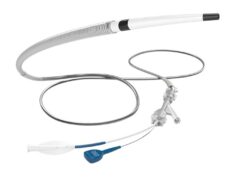
Focused ultrasound has the potential to radically change how diseases and conditions are treated. While currently approved for the treatment of uterine fibroids and pain from bone metastases in some geographies, MR-guided focused ultrasound is being explored for a range of functional, oncologic, neurovascular and psychiatric conditions. It concentrates up to 1,000 intersecting beams of acoustic energy with extreme precision, gaining access deep within the brain without harming healthy tissue, ablating targeted areas without exposing the brain to the effects of ionising radiation.
Focused ultrasound uses magnetic resonance imaging is used to identify and target tissue, to guide the treatment interactively in real time, and to provide immediate confirmation of the effectiveness of the therapy. Treatments are performed in an outpatient setting without anaesthesia.
More than 400 technical, pre-clinical and clinical scientific papers have been published related to the application of focused ultrasound to the brain. Focused ultrasound treatments for essential tremor, Parkinsonian tremor and neuropathic pain recently received CE marking in Europe.
Essential tremor
Essential tremor is often viewed as a relatively benign disease, however, it can impair the ability to eat, shave, write, perform household activities, and function in the workplace. Medication is typically the first-line therapy; unfortunately, up to 30% of essential tremor patients do not respond and may therefore be considered as candidates for surgical treatment which includes thermal ablation of nerve cells or deep brain stimulation.
The feasibility, safety and preliminary effectiveness of focused ultrasound has been demonstrated by a pilot clinical trial that treated 15 medically refractory patients with essential tremor. Launched in 2011 at the University of Virginia (UVA) and funded by the Focused Ultrasound Foundation, the study used an investigational MR-guided focused ultrasound device to perform a completely non-invasive unilateral thalamotomy. Similar pilot studies are also underway at Sunnybrook Health Sciences Centre at the University of Toronto in Canada, Yonsei University Medical Center in Seoul, Korea, and at the Center for Ultrasound Functional Neurosurgery in Solothurn, Switzerland.
Focused ultrasound is used to lesion the cells deep in the brain that are responsible for the tremor. There is no general anaesthetic required. During the treatment, real time feedback from the MRI functions as a thermal “map” for the surgeon.
In the UVA study the treatment aim was to improve essential tremor symptoms on one side of the body, particularly in the dominant hand of each patient. Preliminary data showed a 78% improvement in contralateral tremor scores and a 92% increase in functional activities scores. Outcomes and complications were comparable to other procedures for tremor, including stereotactic and radiofrequency thalamotomy and deep brain stimulation.
Both of these pilot studies laid the groundwork for a pivotal phase III trial approved by the FDA in February 2013. Intended to provide the safety and efficacy data needed for FDA pre-marketing approval, the multicentre study is expected to begin in mid-2013 and will be led by UVA neurosurgeon W Jeffrey Elias. The trial will be a double-blinded and will randomly be assigned to either a treatment or control group. The study’s follow-up will be one year. If the pivotal trial confirms the positive findings from the pilot studies, focused ultrasound may be cleared to fill the treatment gap experienced by essential tremor patients who have failed drug therapy and are not candidates for surgery.
Parkinson’s disease
Currently, drugs or surgery provide only symptomatic improvement for Parkinson’s patients. Even with optimal intervals and dosages of medication, the amount of time spent with good motor control declines in late-stage Parkinson’s disease, and it is at this point that patients consider surgical options to improve their quality of life. Surgical options include deep brain stimulation or surgical lesioning.
The Focused Ultrasound Foundation is also funding a clinical trial investigating the use of focused ultrasound technology in treating patients with tremor-dominant Parkinson’s disease. The study began treating patients in late 2012 to evaluate the technology’s feasibility, safety and preliminary effectiveness for medication-resistant Parkinson’s disease.
This trial, also being conducted at UVA, is an FDA-approved double-blinded protocol study, 30 patients are randomly assigned to either treatment or sham control groups.
Obsessive compulsive disorder
Jin Woo Chang, director of the Brain Research Institute at Yonsei University Medical Center in Seoul, South Korea, treated the first of fifteen patients as part of a pilot clinical trial evaluating the feasibility, safety and preliminary efficacy of focused ultrasound as an obsessive compulsive disorder therapy.
This milestone marks the first step in developing a non-invasive alternative to surgery for certain patients disabled by obsessive compulsive disorder. If this study and subsequent trials confirm the safety and efficacy of focused ultrasound in treating obsessive compulsive disorder, it may be possible to improve the quality of life for large numbers of certain patients and possibly lead to new treatments for depression and other psychiatric conditions.
Chang has been treating obsessive compulsive disorder using radiofrequency to make lesions in areas of the brain. During the past year, he has used focused ultrasound to perform brain lesioning in a clinical trial involving essential tremor patients and hypothesises that the investigational technology may be as effective as radiofrequency ablation.
In the current study, Chang plans to treat areas of the brain that are conventional targets for lesioning—the anterior cingulate cortex, the anterior limb of the internal capsule and the sub caudate nucleus. For the first five patients, bilateral lesions on the anterior limb of the internal capsule will be made. The anterior limb of the internal capsule is a well-known target for treating obsessive compulsive disorder with radiofrequency ablation and deep brain stimulation. Until now, targeting the internal capsule was considered to be beyond the reach of transcranial focused ultrasound.
The first study patient had no noticeable complications from the treatment; it may take several months for the full effect of focused ultrasound lesioning to be realised as obsessive compulsive disorder symptoms do not stop immediately after surgery, even with deep brain stimulation and other conventional lesioning techniques.
Other brain applications
Brain tumour patients are those to possibly gain the most from focused ultrasound technology. As this modality is non-invasive and accurate, it has the potential to thermally ablate only targeted tissue while sparing healthy adjacent brain tissue, reducing the risk for infection and bleeding, lowering procedural morbidity by avoiding the need to open the skull and avoiding ionised radiation related toxicity.
In addition, focused ultrasound allows localised transient opening of the blood brain barrier, thereby enabling an increased drug delivery to targeted areas in the brain. This has the potential to augment effects of the currently used chemotherapies as well as the usage on new drugs.
Focused ultrasound may someday be used in the treatment of temporal lobe epilepsy, thereby providing a low morbidity means to target and destroy a specific area in the brain while sparing healthy tissue adjacent to the target or along the beam path.
In addition, research on focused ultrasound has demonstrated its use for neuromodulation; it is possible to stimulate or block brain activity in a transient and focalised manner.
A recent study demonstrated the feasibility of MR-guided focused ultrasound treatment of intracerebral haemorrhage. In a cadaveric model, large-volume intracerebral haemorrhage were liquefied with transcranial sonothrombolysis and evacuated in a minimally invasive manner.
The technology can also offer accelerated recovery and return to normal life, reduced risk of infection, damage to the non-targeted area, and blood clot formation, and rapid resolution of symptoms.
Neal F Kassell is the Founder and Chairman of the Focused Ultrasound Foundation, USA










